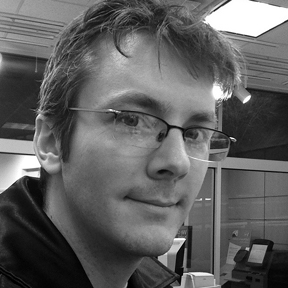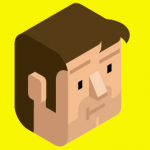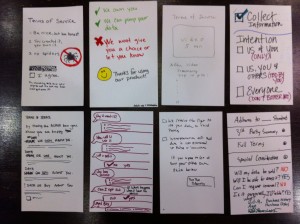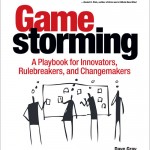
JAMES MACANUFO
Everything around us—our cars, our shoes, and all the sensors we don’t see- are churning out a sea of data. A world of new services is coming to be around this “Internet of Things” and its data exhaust all around us… so what’s a designer to do? How might strategists, architects, designers and technologists get together and do what we’re good at- creating the services and business models that will define our near future?
James is a co-author of Gamestorming and a thought-leader in facilitation and interaction design. I had the opportunity to talk with him about his presentation at this year’s IA Summit in Baltimore, The Collaborative Design of Smart Things.
HERE’S THE TRANSCRIPT
James: So this is a fun workshop for me because I’m more used to doing training with people on gamestorming; people are really interested in that and how to apply it their own context in whatever they are doing. So for me, this is a little self-indulgent because what I’ve done is taken some of the techniques for gamestorming and actually just applied them to a topic that I’m super interested in. I’m really fascinated by the increasingly blurry boundary between the digital and the analog worlds. I’ve noticed experiences are not just digital anymore. We are starting to incorporate things you can call them ‘smart’ things into the conversation. One of the outcomes of that is the experiences are throwing off a lot of data as well. Data about everything from the simple example is from the Nike fuel platform. It’s a sensor that’s in your shoe, it’s a whole ecosystem that you experience and has a social layer to it, it’s great!
There are plenty of healthcare applications as well coming on line now so one of the topics I talked about in the workshop is this thing called intelligent M which is an RFI reader plus an accelerometer that monitors compliance in hospitals. Nurses and doctors wear it and it can tell when they are washing their hands and how often they are washing their hands and I don’t know if it keeps track of if they are singing happy birthday 2 xs in a row. It’s a really fascinating thing to me right now I have more questions than answers about what it means to designers in this workshop it’s just an opportunity for me to pose some of those questions and have them step into the white space and say well what does change when suddenly you are collecting all of this data about people and it is mostly data about people and their behavior. What do you do with it? What do you tell them about what you do with it? What do you not tell them? It’s a little bit of the Wild West when it comes to these kinds of things. In some cases the way I describe it there is a spectrum between the machines taking over sort of the creepy moments; you know big brother is watching us at all times and collecting data about our whereabouts our status and things like that all the way over to actually there are some really fascinating things made possible by this new world of data. It’s more of the unicorns and rainbows sort of vision of the future where all of our stop lights are precisely timed with traffic and we’ve cured cancer and asthma and things like that.
So what are we going to do about that? And one of the questions we need to ask ourselves as designers is people who actually want to bring good into the world – What are we going to do with all of this?
Lara: [and then you talk about the ethical use of that data… a lot of that is hidden today from the user and unfortunately a lot of people agree to things they don’t know they are agreeing to, or they read it and get freaked out.]
James: Let me ask you, have you read your iTunes agreement every time they update it? All 47 pages of it?
Lara: [I scanned it the very first time.]
James: Well good for you, that’s probably more than most people do.
One of the things we do in the workshop is redesign that experience for the first page so that when your terms and services has been updated what would you want that to look like? What information would you want presented to you? What decisions do you have to make? I’ve collected a bunch of those and will post them online because I think they are really fascinating. My favorite one was “Hey, we are going to do whatever we want with your data; we are going to buy it and sell it and that’s just the way it’s going to work. Hope you love our product. ” But then there were other clever ideas as well. I should say there’s actually people really working on this. There is a site out there called Terms of Service Did Not Read and their premise is basically that Terms of Service is the biggest lie on the internet but no one really reads it, we just blindly step into it and they are interested in driving the conversation further as well. What do we need? Do we need nutrition labels for data policies? Let’s first become more aware of this stuff and the issues in general around it before we start making decisions around it or start reacting poorly because like I said there is a spectrum of possibility out there.
Lara: [it’s all legalize and then it’s pages long so who has time for that?]
James: One other thing that I brought up is that I have a friend whose name is Kord Davis and is a former colleague that wrote a book called The Ethics of Big Data, which by the way is the best O’Reilly cover ever. One of the points that he makes in the book is that we talk about things like privacy a lot. Privacy is most of the conversation around data and there is certainly a lot of stuff about privacy that we could be concerned with but he brings up some other points for instance, ownership, and this is something we explored in the workshop. Who owns data about you? How tall are you? [5’1”] Okay, who owns that information? [my doctor] Some people would say that’s public information; it’s stuff that’s out there. You’re in a public park and someone takes a picture of you. They say this person is 5’1” and they were here at this location. That’s publically owned information. So even that one, you start to wonder, well, if you own something …
Ownership is as much an issue as privacy. When we create data, so when you take a picture you feel a certain sort of intuitive sense that you own that thing. When you share it on a social network then who then owns it? We believe there are rights associated with ownership that you can buy and sell it or do other things with. It’s a very grey area right now in terms of policy and the law is always going to react to what technology makes possible. These things are possible right now and we haven’t caught up in the strict organizational sense around the rules. So it’s great! We have a chance to decide what that’s going to be and push that conversation forward. I would love to see more designers talking about these kinds of things.
Part of it also is I identify with the title designer and a lot of my friends are designers, or recovering designers and designers want to make stuff they want to make experiences that are in the world that bring people joy and things like that so when you add when you bring this up in a conversation it is inherently less interesting and part of what I was trying to do with the workshop is get people interested in it. Because increasingly we are in conversations even the classic scenario is a whiteboarding meeting and there are technology people there, product management people there architects, designers, that kind of things and somebody says the technology guy says “Oh, you know what? This is totally possible we could do this with the data and if we bring in this other data about people we can correlate it and put together yadayada. We can do this!” And if you poll the people in the room two of them say, “That’s a great idea! Let’s do it!” and one of them says, “Oh wait, that’s kind of creepy. “ So creepy is a wall that we need to get past. We need to find exercises, methods, etcetera, a language to get past that moment so that we can go back to making cool stuff.
[like how comfortable can you get the user and how far can you take it without going too far?]
And keeping people appropriately in the loop. Some of my friends are on Facebook and they are pretty smart people and they still can’t figure out who they are sharing what with. Not to bring Facebook into it, I mean their mission is to make the world more open and connected, right? So there’s hearts and unicorns and rainbows around that sounds wonderful
Lara: [Let’s go back to the creation of things and bringing that process back to life.]
James: One of the other things that I’m so excited about right now is just how much more access to tools we have in terms of things like… If you’re a designer and you’re not interested in getting an Arduino Kit and printing something out in 3D as an enclosure and making a thing then, I don’t know, you might be shutting off some interesting stuff. Our Lego sets are getting bigger and more fun to play with and cheaper to access so I brought some of that into the workshop as well.
Lara: [We skipped the background. Why don’t you share how you got started in all of this?]
James: My first career a long time ago was in infographics. I was an infographics geek and worked briefly at Newsweek with a really amazing guy called Karl Gude and really thought that was going to be the thing for me was I’m going to make maps and charts because they are so powerful and in terms of media in general we are seeing it now, it’s very easy to skip the article. What I remember is that people would carry around the newspaper but I’m not sure if they read it, they just carried it around. However, they would have a different experience with maps and diagrams things.
It was educational, playful, that was my first career. And from there I went and found what I thought was the best company in the world that did that and worked there for seven years and that company was called Explain, which is a verb. They explain things. We got to explain a lot of cool stuff. Some of my favorite work was the work we did with The Department of Education explaining, visualizing what the school of the future would look like. It was called “School 2.0” at the time and that was back when 2.0 wasn’t a gouache term. I don’t know what we are on now, what number we are on now, but it was fun work because I think that visuals and explanations especially the ones that get past all of the chart junk that you see online now and actually explain things to people and contextualize them. They are powerful now and they always will be.
So from there I wound up doing the consulting part of it and that’s how I got into collaboration because to make these pictures you have to get people to agree to what’s in the picture. So you have to get good at collaboration. I think that applies to all of design really. [I agree.] As the complexity increases you need to get good at the soft part which is how to get people to create things together. That’s also something that designers need to think about. You see it in the program here [he’s talking about the 2013 Information Architecture Summit] A lot of the workshops are on things how to do things like that.
Lara: [and what do you think is the biggest challenge in corporations to collaborating?]
James: Collaboration isn’t always the answer, it’s a mode for certain parts of the process but sometimes you have just got to get things done. So I don’t default to collaboration as always the best thing but I could certainly see more collaborative more participatory design being done in strategy work because what typically happens is they all have this story, this four, five year plan we are going to go on a journey, we are going to pivot, transform. You go through the list of Fortune 500 and they are all going through some sort of transformation. Big, small, whatever. And I just don’t know if that story is true anymore because what typically happens is, it fails. They start on high with it and it’s coming from an executive retreat or an outside consulting firm this future vision. They come up with a 5 year plan and they might make some PowerPoints and then it just sits on a shelf or it doesn’t go anywhere or it just gets caught up in some sort of organizational dysfunction. The role that collaboration might play in that is the front end which is be more participatory about the inputs into that process.
Another friend of mine Dave Gray who recently wrote with Thomas Vander Wall “The Connected Company” and he lays out a lot of the principles in terms of using what’s now available to us in terms with social interactions and things like that to make those transformations possible. It’s a good book. I recommend it. The cover is a nice color too, it’s a nice Tiffany blue.
Lara: [when you were young did you know this is what you wanted to do?]
James: I still don’t know what I want to do. Hhahha I think that everybody should have at least a couple of careers in their lives a couple of degrees they don’t use so for me the next big thing the way I describe it to people is I want to learn how to turn some wrenches. Doing more coding. As a hobby I have been developing some video games because I think they are still so much to be explored in that art form and that’s the stuff I’m interested in pursuing now and it does tie back to the smart things as well.
Lara: [what’s one of the video games you are working on?]
 James: The one I have a sketch of right now is about making choices and things get bigger or smaller and that’s all I can say about that right now. So I will do a little self-promotion, my game double Double Dopple waffle did very well in China I don’t know why. Basically you control two characters and they move in opposite directions and you have to bring them together.
James: The one I have a sketch of right now is about making choices and things get bigger or smaller and that’s all I can say about that right now. So I will do a little self-promotion, my game double Double Dopple waffle did very well in China I don’t know why. Basically you control two characters and they move in opposite directions and you have to bring them together.
Lara: [I’ll have to take a look at that.]
James: I can’t promise you’ll like it. The sound is really good. I like the sound.
Lara: [Well, thanks for being on UX-radio]
James: Gosh, this was fun!
Don’t wait – Buy this book today at O’Reilly!
MORE ABOUT JAMES
James is currently an Instructor of Interaction Design at the Washington University in St. Louis where he leads a workshop-based course on the principles and methods of Interaction Design.
You can find more about James here:
Macgeo.me
Tintanker.com
@macgeo







6 Comments
Wonderful feedback Jen! Thanks so much for listening to the show.
This is a great website for anyone in the UX field. I thought the questions were thoughtful and interesting. The interviewer obviously has done her research to ask such thorough questions. Though this website is still young, I know that this collection will grow in to a great library of valuable resources. I particularly like that the transcript is included with the podcast in case I want to follow along with the interview or just read the interview at a time I cannot be online. Lara and her team have tapped into a market that is ready to grow. And they are just the team to run with it. Thanks for all of the work you do to bring us the great information.
I love origin stories. Cool to hear how he got his start in Infographics.
Awesome, congratulations on the launch! Super exciting!
Congrats on your first interview, Lara! Sounds great 🙂
WOW! What a great interview.